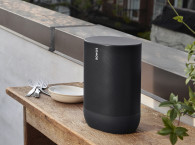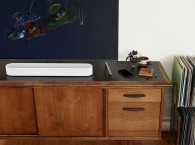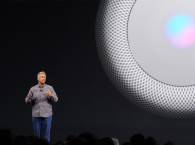
Anticipating tough competition in its traditional space, the Sonos One is basically an updated version of the Sonos Play:1 speaker, keeping with a similar design, and adding processing features and a six-microphone far-field array to be able to support voice personal assistants. Sonos promises complete integration with existing Sonos speakers, with the advantage that adding the new Sonos One will unlock support for Amazon Alexa, avoiding users having to add an Amazon Echo. Apart from the already recognized sound quality and multiroom support, the big argument for Sonos will be cross-compatibility with all the music services, including Apple Music, as well as support for any voice personal assistant (VPA).
Many users will see the new Sonos One as a better alternative to an Amazon Echo Plus, without being locked to any of the leading-brand's voice engines, playing well in particular with Apple's devices, including Apple AirPlay 2 support promised for 2018. At launch, users in the US, UK, and Germany can ask Amazon Alexa to control Sonos One out of the box, with full voice support for Amazon Music, iHeartRadio, Pandora, Sirius XM, and TuneIn. Alexa voice control for Spotify on Sonos One will be coming soon after launch. Voice transport controls like pause, skip, volume up and down, and even asking what’s playing will be available for all other music services Sonos supports.
In addition to support for music, Sonos One will allow owners to enjoy all the other things people already know from Alexa – like requesting weather updates, set timers, listen to news and traffic reports, and even hear the latest sports scores. And like any other Amazon device, Sonos One with Amazon Alexa will keep getting smarter through cloud updates. In 2018, the Google Assistant will also be supported by the Sonos One, making it the first smart speaker to support multiple major voice services.

“We live in a golden age of streaming entertainment,” says Sonos CEO Patrick Spence. “But so much of this great content is being pushed through smart speakers that aren’t designed with sound quality in mind. With our open approach to collaboration, agnostic approach to voice services, the strength of our many innovative partners, and a sound platform designed for the whole home, we’re helping people listen more and listen better.”
As part of the Sonos home sound system, Sonos One can be used as a standalone speaker, wirelessly paired with another one for stereo sound, or used with the Songs PlayBase or PlayBar to create a complete - wireless - home theater surround sound system. Inside each Sonos One there are two Class-D digital amplifiers, one tweeter, and one mid-woofer - a similar arrangement to the previous Play:1. The six-mic array for voice support is also complemented with advanced beamforming, echo cancellation, and an adaptive noise suppression algorithm, to focus on the right person and ensure the voice service understands everything clearly.
Voice capture technology with echo cancelation allows the speaker to still hear the user over the music. The volume also intelligently lowers, or “ducks,” when users speak to it so they don’t have to shout over the music. The light on the speaker will be illuminated when the microphones are active - and the light is hardwired to the same circuit that powers the microphone array, so if the light is off, it means the microphone is actually off. The processing power within the speaker is also used to improve the Trueplay technology that Sonos already implemented in the Play:5, allowing to easily tune the speaker to any acoustic environment.
Like all other Sonos products, the new Sonos One relies only on WiFi, and not on Bluetooth, allowing expanded home coverage using any 802.11b/g, 2.4 GHz broadcast-capable router for uninterrupted wireless streaming. There is also an Ethernet port to wire directly to a router to operate Sonos if Wi-Fi is unstable, or to provide Internet accessibility to non-wireless devices. Sonos One will be available in all-white and all-black matte finishes.

Sonos owners in the US, UK, and Germany will also be able to control their entire Sonos systems using Amazon Alexa, thanks to a free software update the company made available in tandem with the Sonos One announcement. All that’s needed is a Sonos One or any Alexa-enabled device like an Amazon Echo or Echo Dot and the Sonos skill for Alexa. Users will be able to play a song, skip forward and back through playlists, target one room or an existing group of rooms, and adjust volume – all using voice. Additionally, Amazon Music users can ask for music based on decade, genre, tempo, mood, or even lyrics if they can’t remember the name of a song.
Sonos also announced that it will begin supporting Apple’s AirPlay 2 in 2018, making it possible to play any sound from an iOS device – including YouTube videos and Netflix movies – on Sonos speakers throughout the house. Owners will also be able to ask any Siri-enabled device to control music on Sonos speakers.
Since 2016, Sonos owners have been able to control Sonos directly from the Spotify app. By the end of 2017, Sonos owners will be able to control Sonos directly from additional music service apps, including Pandora and Tidal. Direct control from the Audible, iHeart Radio, and Kuke Music apps will come in early 2018, the company confirms.
Available immediately, Sonos owners will see a refreshed app experience when they update their software. The app will continue to play a key role alongside voice and partner apps, all working together and complementing each other. New updates include simpler navigation, prominently placing the controls that matter most through a navigation bar at the bottom of the screen, making it easier to move music around the home and browse and access favorites from any service quickly.

In 2018 Sonos will also open its developer program and deliver APIs to any developer who wants to build compelling customer experiences on the Sonos Sound Platform. Partners and developers will have access to the tools, documentation, and support they need to drive faster innovation. The company also rolled out a certification program. Partners will have the ability to earn the “Works with Sonos” badge so Sonos owners will have assurance that companies building and innovating on the platform deliver experiences that meet the Sonos high bar for quality. First certified partners will start rolling out in the coming weeks and months, starting with Wrensilva, TunesMap, Lutron, iPort, Wink, Yonomi, and Enno, from China.
Finally, based on the success of its flagship retail store in New York, Sonos announced plans to open another store in London before the holidays, followed by a third location in Berlin in 2018.
www.sonos.com








